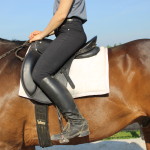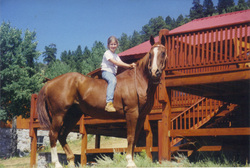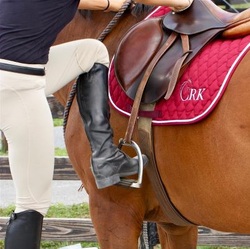Do you grip when you ride? Perhaps you’ve been told to hang on with your legs for security or to keep a “tight leg” to get your horse going.
Or maybe you’ve been told not to hold on with your legs but you aren’t sure how to stop gripping or how to stay on without gripping!
In this video, I will explain the three most common places that riders grip, why gripping with any part of your leg is bad for your riding, and then share two exercises to help you stop gripping and ride with better balance.
Hit play to watch the video below.
If you watched this video and are wondering… how do I keep my horse going without a tight leg?… watch this video on Riding a “Lazy” Horse.
See you in the comments!
Callie














44 Responses
Thanks Callie. Great video. This an area that I have been working on with my trainer too. One of the things she shared with me that has helped me is to visualize a soft string from my ankle to the horses hind leg. As I think about the string my legs seem to stay under me better which helps with my balance and therefore reduces my need to grip. Old habits are hard to correct but the improved movement in my horse is a huge motivator. Thanks for the additional insight!! ~ Kristine
Happened to me once. I had just started to canter, and I was in a small indoors arena where you don’t do two 90º-turns, but a U-turn, on the short sides. While pressing with my outside leg to make the turn, I forgot to release pressure with the inside leg. My horse said, “Are you sure you want to go faster? Don’t say I didn’t warn you!”
Well, funnily enough, I thought she was spooking, so I took off all leg and rein pressure (except for some rhythmic tucking on the reins) to calm her down – which she did by the next turn. It was only afterwards that my instructor told me that *I* had told her to go fast.
I can’t wait to try this out thank you Callie. I say wait due to some health problems with my horse currently.
Really good advice Callie thank you. I am aware I can be tense in the saddle, and these exercises will surely help. PS. Bandit is beautiful. I wonder if he is your horse? Thanks again very best wishes Jox
Hi Jo,
Bandit isn’t my horse, he belongs to a friend and client of mine and I get to ride him often 🙂
This was a great lesson along with “Riding the Lazy Horse”. Although my horses aren’t lazy I have always wondered about the gripping with the leg (where, how and when). Here, I learned how to use and not use my legs along with the pressure and release and crop. This was probably one of the most helpful videos for me personally as I have two former trail horses that are like night and day. One responds with almost no cues (I’m sure she was a leader) and the other doesn’t have a clue (a follower perhaps with so many different riders), I say this was probably most helpful but don’t get me wrong, I learn something new and innovative with every video Callie puts out. Thank you again Callie.
Very good video. I will definitely try the exercises
Brilliant as usual, Callie.
Thanks Robert!
I’ve been riding for years but still working on correcting this! I’ve never really understood the “no stirrups” thing though. How are you supposed to post at the trot without gripping to push yourself up out of the saddle? Much appreciated! Love your videos!
Hi Heather,
I don’t usually advocate practicing posting without stirrups because it encourages the habit of gripping. I have ridden, posted, and jumped bareback, but I find that it isn’t as much about hanging on with ones legs as it going with the movement of the horse, so my goal even jumping bareback is not to try and lift myself off their back by hanging on with my legs but rather follow the movement and steady myself enough with my legs that I can close forward with my body over a jump, allow my hip to come forward posting, etc. Hope this helps!
Loved your video on gripping. Gonna practice myself than show other girls to help them also. I think bareback has taught me not gripping as no stirrups to hold legs tight.
Thanks again would love to visit there someday
Hi Callie great video. Yes I probably do grip sometimes. There is always so much to think about when riding
Really well explained – good stuff / thank you
Callie, you just solve one of my big mysteries, and I now know why my feet continuously slide forward. I will check another video and try your exercises at my lesson tomorrow.
My instructors told me, as you pointed in your video, to hold on with my legs and ask the horse to walk faster by using my legs. However, I understand now that with those instructions I grip with my legs and the horse doesn’t walk at the pace I want.
As Heather asked, I’m also interested to know how to trot without gripping.
Great video! Gripping has been a problem for me until recently. Being an older rider it’s a real biomechanic issue of “middle aged tight hip flexors”. So I now do alot of appropriate stretches including glute and hip flexor ones. I have a new young British coach who trained with Mary King and William Fox-Pitt and she showed me a good stretch, again off horse, which has also helped my tight hips enormously. As a result my horse is much freer and can work over his back more effectively and the sitting trot is so much easier. My gripping had been holding us back all this time. In the saddle the stirrupless toe down exercise is a good reminder too.
Dear Callie, I have the same question as Heather. My trainer insists on posting trot without stirrups. I tried your exercises today, and found they helped a lot, allowing my horse to move more forward comfortably.
Another question on the second exercise, moving legs slightly back and putting weight in the heels. Is this the same position for jumping? I am afraid I will pitch forward.
Thank you, Janet
Hi Janet,
Yes! Same position, actually the tendency to pitch forward will be even more so with the legs forward. When the rider’s leg is back and secure, the rest of the body can stay aligned and balanced over the fence. A good exercise is to practice your two point without touching the neck of the horse – this will help you find your balance in your body instead of using the neck or mane to hold on or steady yourself over a jump too.
Great video thank you yes I grip with my knees in trot also so would be good to see that
But I will try these exercises on my horse
Thanks again
Thanks Callie for the great video! Call me ignorant, but I feel as though Im hearing this for the first time. I’ve always thought that you are supposed to be gripping with the lower legs to keep the lower leg still and also to remain balanced on the horse. I also suppose this made sense to me in case the horse would spook or do something abrupt so that I would not have a tendency to fall off. What is the correct amount of pressure? How do you stay prepared physically for a horse to do something not anticipated? Thanks!
Hi Alicia,
No problem, many rider’s first instinct is to grip! As far as your question about how to stay prepared for a horse to do something unanticipated the key is slowly improving your balance. The key to staying on during spooks, jumps forward, etc, is not in how well you were hanging on but how well you are able to keep joints soft not locked, and how quickly you can regain your balance.
Thank you for explaining “wrapping your legs around the horse.” I always thought that meant to keep the leg on ( and probably does when my trainer says it because this is what she advocates). But now I see it is to remain balanced between the thighs, calves and stirrups along with a balanced seat. Also thank you for giving a hint about how to talk to your trainer when attempting another approach. I tried that this morning and it worked great. She agreed that whatever works for me and my pony is fine with her. And by using consistent light aids of the outside leg behind the girth and the inside leg on the girth, and then removing the pressure, I got canters on the correct leads for the first time today! Thanks, Callie
Nice work Janet!
Hi Callie, I loved this video and have been using these exercises in the walk and trot, although I am just learning to canter and I am finding it difficult to keep my body in the saddle during the canter without gripping with my calves. When I relax I slip around in the saddle a lot and can’t find the rhythm of the horse. Do you have any advice? Thanks!
Hi Lara,
When riders struggle with canter, I often recommend working on the sitting trot. Are you able to ride the sitting trot without gripping? If not, this can be a good place to start because while the movement is different, the idea of “following the horse” is the same, and the gait is slower. Also riding a lot of transitions, both into sitting trot and into canter, can be helpful because the first few strides are often the easiest to feel the balance. Hope this helps!
A great video. Thank you for making it. I will try this during my next lesson.
First thank you for all the time and effort you put into your training videos! I was working on this last night and figured out that I am gripping with my legs when my horse is on the bit to help keep my posture against the weight of him pushing into the bit. How do you keep from being pulled forward and stay relaxed?
I have just watched your riding a lazy horse video. I found it very helpful. Our horse will go as slow as possible and often refuses to move, it’s getting very frustrating. The moment I take my leg off he stops . i think he wouldn’t move forward with a squeeze and a tap. Should I sit there until he takes a step and then just repeat every time he stops . I could be there all day just to travel 10 metres 🙂 I am more than happy to invest the time as long as you think this will work. His old rider rode in Spurs and we are too novice to do that so he just ignores our leg . Many thanks
Hi Lynn,
Try tapping with the whip from the ground – as soon as you get forward movement praise and give a treat. Do this until he will go forward from just a voice cue and a touch with the whip (usually only takes a few repetitions). Next, do the same from the saddle. Don’t even use your leg, just tap with the whip. Remember to keep the tapping consistent and stop immediately on forward movement. Also “think” forward – it will work, the key is in the consistency of the tapping and the release!
Hi Callie,
I’ve been to 2 lessons and the instructor told me that when I stay in the saddle I am not alowed to stay on it but to keep my legs tight and support myself in my legs so I don’t stay on the horse in the saddle it’s like I’m staying in a squat position all the time, and I’ve been watching alot of videos on the internet and no one says anything about the way you should stay on the horse. Can you tell me if this is the correct way to stay on the horse? Or I should stay more relaxed with my legs?
Thank you verry much !
Watched this video before I rode today. Can’t believe the difference it made in my canter today. Thank you!
I also watched your video on tension. I hold all my tension in my neck/shoulder area. I really focused on my breathing and literally chanted out loud “breathe, long legs, no gripping, relax shoulders” my entire ride. It really worked! Just glad I was the only one riding today. 😉
Just started watching your videos and they are great; however, I have always had a difficult time at the posting trot. Not sure where it comes from. I hear never use your stirrup to post, you must use your thighs, so now this is all very confusing. If you should not apply any pressure with any part of your leg, and you are not suppose to use your stirrup, how do you correctly post the trot? I also feel like you have to put some pressure in the stirrup in order to keep heels down. Is this correct? I look forward to your reply.
Hi Cheryl,
There will be more weight in your stirrup when you rise in the post – your thigh rests against the saddle and helps to bear weight, but it doesn’t grip.
This is kind of a weird example, but in an old riding text I read that the riders thigh should lay on the saddle like a “slab of raw meat”.
The motion of the horse is what propels the rider forward and up in the posting motion. If the rider’s legs are too far forward and or the rider’s body is too far forward and stiff than this motion will be restricted and create the feeling that the rider has to somehow “lift” themselves by gripping with the thighs or pushing on the stirrup. Hope this helps!
Great analogy, Callie! I’m going to keep this in mind for my next lesson.
Hi Callie,
I really enjoyed watching your gripping videos and I know I will need to do the exercises at the sit and the sitting trot. I will get started with it at my next lesson!
We’d love to hear how it goes for you Laura!
-Julia Burdy, CRK Training Community Manager
Excellent video on not gripping!
I used to grip years ago, but my western horses have taught me to hung loose. They will not canter if there is any tightness in my back, hip or leg. So straight from the horses mouth LOL
Hi, Callie! I’ve started riding again after a 40-plus year hiatus. I took lessons in college, and I suspect I didn’t get the best training. I recently started helping friends with their horses, bartering chiropractic care for regular feeding, watering, mucking out, grooming. I decided to take lessons from a reputable professional so I wouldn’t “wreck” my friends’ horses or make a fool of myself. My instructor is fabulous, and after six weeks, I’m up to learning the canter. My seat and balance are nowhere near where I want to be, but I’m ok with the fact that it’s going to take time — and I have time to do it right this time. Your videos are a wonderful supplement to my weekly lessons. I live in the heart of Virginia hunt country, and my goal is to fullfill a long-held dream: foxhunting! We start cubbing this fall, and my instructor says I’ll be ready by September to begin at the hilltopper level. Thank you for the very clear instructions, exercises, and thoughtful presentation.
Thank you for this video…hanging the legs and pointing the toes reminds us how it’s suppose to feel…to not grip.
What name brand is the little kids saddle that the little girl is riding the pony in ..and where can you buy it?
Hi Diane, I’m not sure which kid’s saddle you are referring to!
-Julia Burdy, CRK Training Community Manager
My riding breeches slide around when I ride. So, gripping with my thighs doesn’t help. Any helpful ideas? Thank you.
Hi Joan, do you ride in the same kind of breeches? Have you tried full seat breeches? Do you find that it happens in all saddles? Also, I want to make sure that it is clear that you don’t want to grip with your thighs. The important thing to take away from this video is the weight distribution.
-Julia Burdy, CRK Training Community Manager
Hi, I’m a brand new rider. Never been on a horse in my life but I’m about to get my first taste of it in a cpl days. I wanna make sure I understand what your saying..I should just relax and more or less let my body follow the rhythm of the trot or gallop or even a faster run. Is that correct?
Hi Ronnie, that is so exciting! Yes, you want to be soft to follow the movement of the horse in all gaits 🙂
-Julia, CRK Training Community Manager